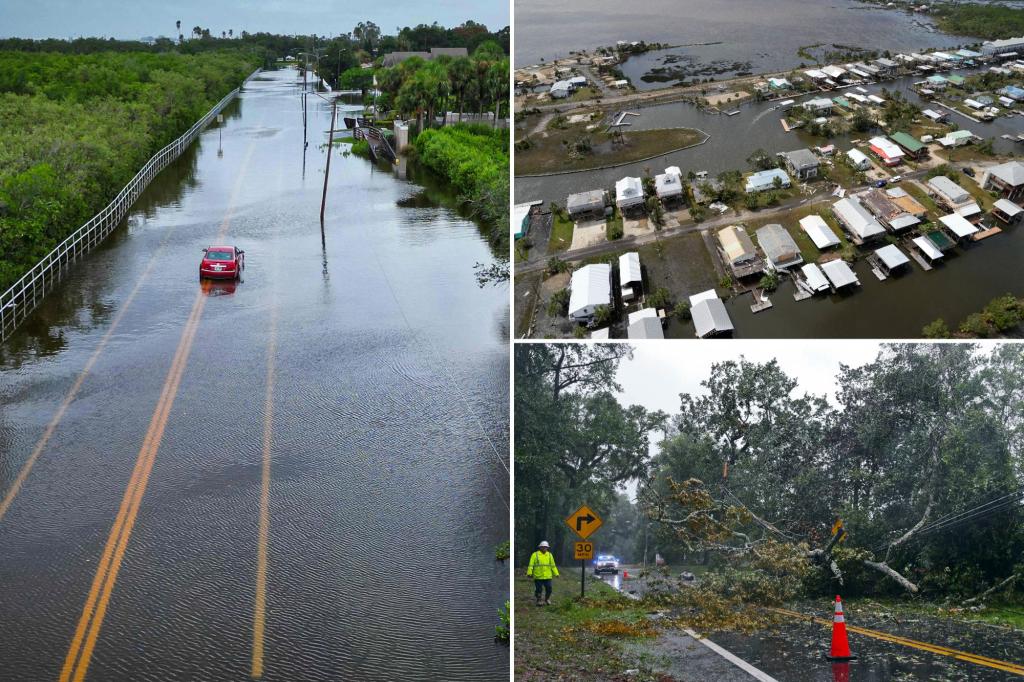Hurricane Idalia crashed into Florida as a fearsome Category 3 storm Wednesday morning, ripping roofs off homes and leaving entire neighborhoods submerged before tearing into Georgia and sending residents scrambling for cover.
The historic storm’s assault began in Florida’s sparsely populated Big Bend region at 7:45 a.m., toppling power lines, unmooring boats and propelling debris as water levels vaulted 9 feet in just two hours.
“All hell broke loose,” said Belond Thomas of hard-hit Perry, Florida.
Thomas and his family relocated to an inland motel to ride out the storm — but didn’t venture quite far enough.
The building’s roof eventually tore off, showering the huddled clan with debris.
“It was frightening,” he said. “Things were just going so fast. Everything was spinning.”
As of Wednesday afternoon, at least 500,000 residents remained without power across Florida and Georgia while line crews raced across both states to repair the damage.


Officials said at least two people died in vehicle accidents during the storm’s north Florida rampage, with winds of up to 125 mph creating chaos on roadways.
A 59-year-old Gainesville man was killed after careening into a ditch and crashing into a tree line, highway patrol officials reported.
In Pasco County, a 40-year-old man drove his pickup truck “too fast for conditions” and lost control due to “inclement weather,” authorities said.


“Don’t put your life at risk by doing anything dumb at this point,” Gov. Ron DeSantis cautioned at a news conference Wednesday morning. “This thing’s powerful. If you’re inside, just hunker down until it gets past you.”
DeSantis said he had activated 5,500 National Guard troops and 30,000 utility workers ahead of Idalia’s potentially “catastrophic” landfall.
‘Trying to swallow us up’
Cedar Key Island resident Michael Bobbitt told the BBC Wednesday morning that Idalia — the largest hurricane to hit the area in more than a century — had engulfed much of his town’s commercial center.
“Our entire downtown is underwater,” he said. “Part of a whole hotel just broke apart and went into the Gulf. It’s like the Gulf is trying to swallow us up.”

The system also upended travel plans for thousands of fliers as airports closed in advance of the hurricane’s approach, leading to mass cancellations in Florida and Georgia.
Idalia weakened before whipping into Florida’s capital of Tallahassee but still managed to knock out power to thousands.
DeSantis said his wife, first lady Casey Desantis, called him as the storm raged to relay that a large oak tree split in half and crashed on the governor’s mansion during the deluge.
“Mason, Madison, Mamie and I were home at the time, but thankfully no one was injured,” she wrote on X along with a picture of the severed tree.

President Biden — who partially blamed the storm on worsening climate conditions — said he had spoken to DeSantis and pledged to provide “him with everything that he possibly needs.”
The governor said that there were reports of looting in Steinhatchie in Taylor County, warning would-be thieves that local gun owners would be quick to exercise their 2nd Amendment rights.
Florida Division of Emergency Management Director Kevin Guthrie said that search and rescue squads were responding to trapped residents in hard hit areas — but did not expect mass casualties.
“They are 100% OK,” he said. “We’re going to get to those folks just as fast as we can get our emergency access teams to them.”


Downgraded to tropical storm
After hitting Tallahassee, Idalia exited the Sunshine State and rolled into Georgia as a weakened Category 1 hurricane, blasting the southern portion of the state with high winds and rain.
The system eventually weakened into a 70 mph tropical storm by early Wednesday evening, according to an advisory from the National Hurricane Center.

Officials warned that Idalia could still induce storm surges in Georgia and the Carolinas through Thursday.
With portions of the Sunshine State still struggling with the lethal impact of Hurricane Ian, Florida officials had worried that Idalia could plunge other areas into prolonged chaos.
But DeSantis said late Wednesday that the system’s impact could have been much worse.
‘The storm moved a little bit faster than some of the other ones moved,” he said. “Some of these things will just dump water when they go so slow. This one was a little bit faster. When you’re talking about the flooding it’s a little bit better when they’re slow.”
The National Oceanic and Atmospheric Administration has warned that unusually high ocean temperatures could induce a far more severe 2023 hurricane season than had originally been forecast.
Additional reporting by Isabel Keane
With Post Wires
𝗖𝗿𝗲𝗱𝗶𝘁𝘀, 𝗖𝗼𝗽𝘆𝗿𝗶𝗴𝗵𝘁 & 𝗖𝗼𝘂𝗿𝘁𝗲𝘀𝘆: nypost.com
𝗙𝗼𝗿 𝗮𝗻𝘆 𝗰𝗼𝗺𝗽𝗹𝗮𝗶𝗻𝘁𝘀 𝗿𝗲𝗴𝗮𝗿𝗱𝗶𝗻𝗴 𝗗𝗠𝗖𝗔,
𝗣𝗹𝗲𝗮𝘀𝗲 𝘀𝗲𝗻𝗱 𝘂𝘀 𝗮𝗻 𝗲𝗺𝗮𝗶𝗹 𝗮𝘁 dmca@enspirers.com


